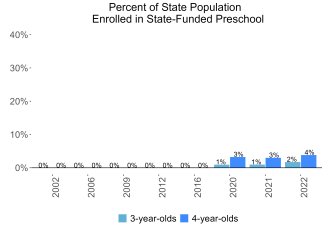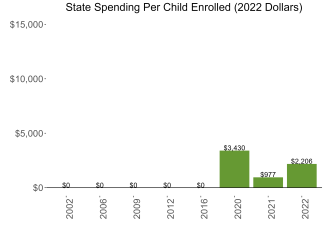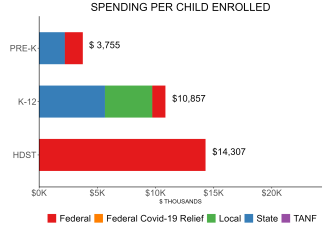
State of Preschool
Access Rankings
Resource Rankings
Total Benchmarks Met


Overview
During the 2021-2022 school year, Utah preschool enrolled 2,813 children, an increase of 730 from the prior year, as the program began to recover from the impact of the COVID-19 pandemic. State spending totaled $6,206,636, up $4,172,453 (205%), adjusted for inflation, since last year. State spending per child equaled $2,206 in 2021-2022, up $1,230 from 2020-2021, adjusted for inflation. Utah met 3 of 10 quality standards benchmarks
What's New
The number of children served by the School Readiness Grant program in 2022-2023 decreased as a result of increased costs to provide high-quality preschool services and some previous grantees no longer being part of the grant program.
In December 2022, Utah was awarded a federal Preschool Development Grant Birth through Five (PDG B–5) renewal grant for $4.8 million. The state will use PDG B–5 funds to update Utah’s statewide early childhood needs assessment, establish and extend technology to increase parent and family engagement in early childhood programs, and increase training and coaching for early educators.
Background
In 2016, the High-Quality School Readiness Expansion (HQSR-E) grant program was established to expand access to high-quality school readiness programs for eligible children. The HQSR-E grant program provided grant funds to LEAs and private providers with existing early education programs deemed high-quality, as determined by the ECERS-3 tool and additional quality rating criteria. School readiness programs were eligible to apply for HQSR-E funding if they provided services to economically disadvantaged 4-year-old children, could illustrate how funds would be used to expand their preschool programs, and were deemed high-quality based on the criteria noted above. The HQSR-E program ended in June 2019 but was replaced by the Expanded Student Access to High Quality School Readiness (ESA) grant program.
With the passing of SB 166 in 2019, the School Readiness Board governs both the Becoming High-Quality (BHQ) and ESA grant programs for both public and private providers. The BHQ program provides funding to help existing preschool programs increase program quality to later qualify for ESA grant funding. The ESA program allows high-quality preschool programs to expand access and provide seats to eligible students. An eligible student is one who is economically disadvantaged and whose parent or guardian reports they also have experienced at least one risk factor (e.g., mother is 18 or younger, parents with a low reading ability, exposure to substance abuse) or a student that is an English Learner.
This new legislation also codified Utah’s UPSTART Program. The program provides a home-based, technology-delivered kindergarten readiness program to children throughout the state and prioritizes children from low-income families. The program includes an annual independent evaluation contracted by the Utah State Board of Education (USBE).
In May 2020, the new Utah Core Standards: Early Learning (Ages 3-5) were approved by the Utah State Board of Education (USBE). USBE staff collaborated with other agencies and early childhood professionals to provide professional learning during the 2020-2021 school year to encourage and assist with the implementation of the new standards starting in the 2021-2022 school year.
Expanded Student Access to High Quality School Readiness Programs (ESA)
Access
Resources
| Total state pre-K spending | $6,206,636 |
| Local match required? | No |
| State Head Start spending | $0 |
| State spending per child enrolled | $2,206 |
| All reported spending per child enrolled* | $3,755 |

Pre-K programs may receive additional funds from federal or local sources that are not included in this figure. K–12 expenditures include capital spending as well as current operating expenditures. Head Start per-child spending includes funding only for 3- and 4-year-olds.
Utah Quality Standards Checklist
| Policy | Requirement | Benchmark | Meets Benchmark? |
|---|---|---|---|
For more information about the benchmarks, see the Executive Summary and the Roadmap to State pages. | 3benchmarks met | ||
| Early Learning & Development Standards Benchmark | Comprehensive, aligned with child assessments, supported, culturally sensitive | Comprehensive, aligned, supported, culturally sensitive | |
| Curriculum Supports Benchmark | Approval process | Approval process & supports | |
| Teacher Degree Benchmark | CDA or AA (ECE not required) | BA | |
| Teacher Specialized Training Benchmark | ECE, CD, Elem. Ed., ECE SpEd, SpEd | Specializing in pre-K | |
| Assistant Teacher Degree Benchmark | None | CDA or equivalent | |
| Staff Professional Development Benchmark | Coaching | For teachers & assistants: At least 15 hours/year; individual PD plans; coaching | |
| Maximum Class Size Benchmark | 20 (3- & 4-year-olds) | 20 or lower | |
| Staff to Child Ratio Benchmark | 1:10 (3- & 4-year-olds) | 1:10 or better | |
| Screening & Referral Benchmark | None | Vision, hearing & health screenings; & referral | |
| Continuous Quality Improvement System Benchmark | Structured classroom observations; Data used for program improvement | Structured classroom observations; data used for program improvement | |

